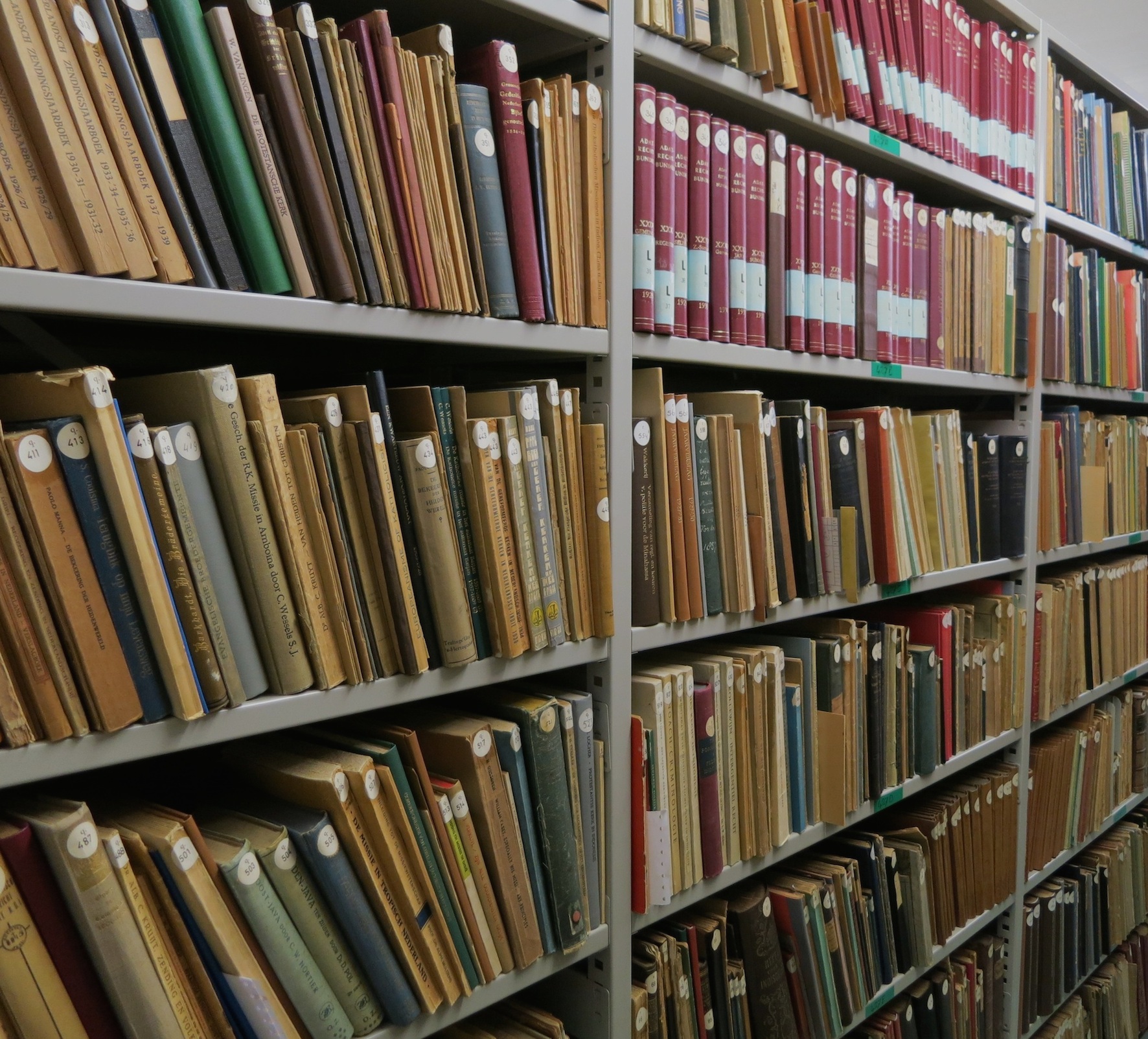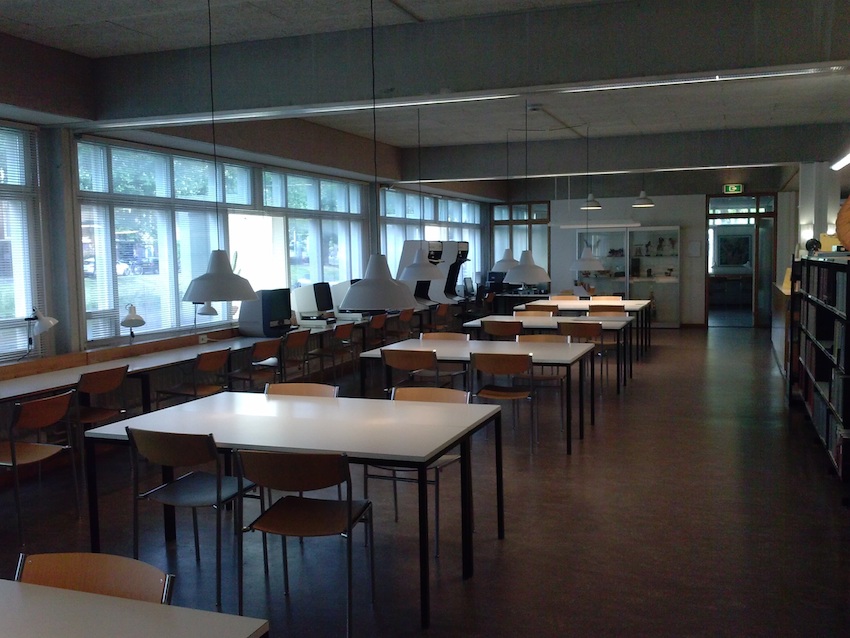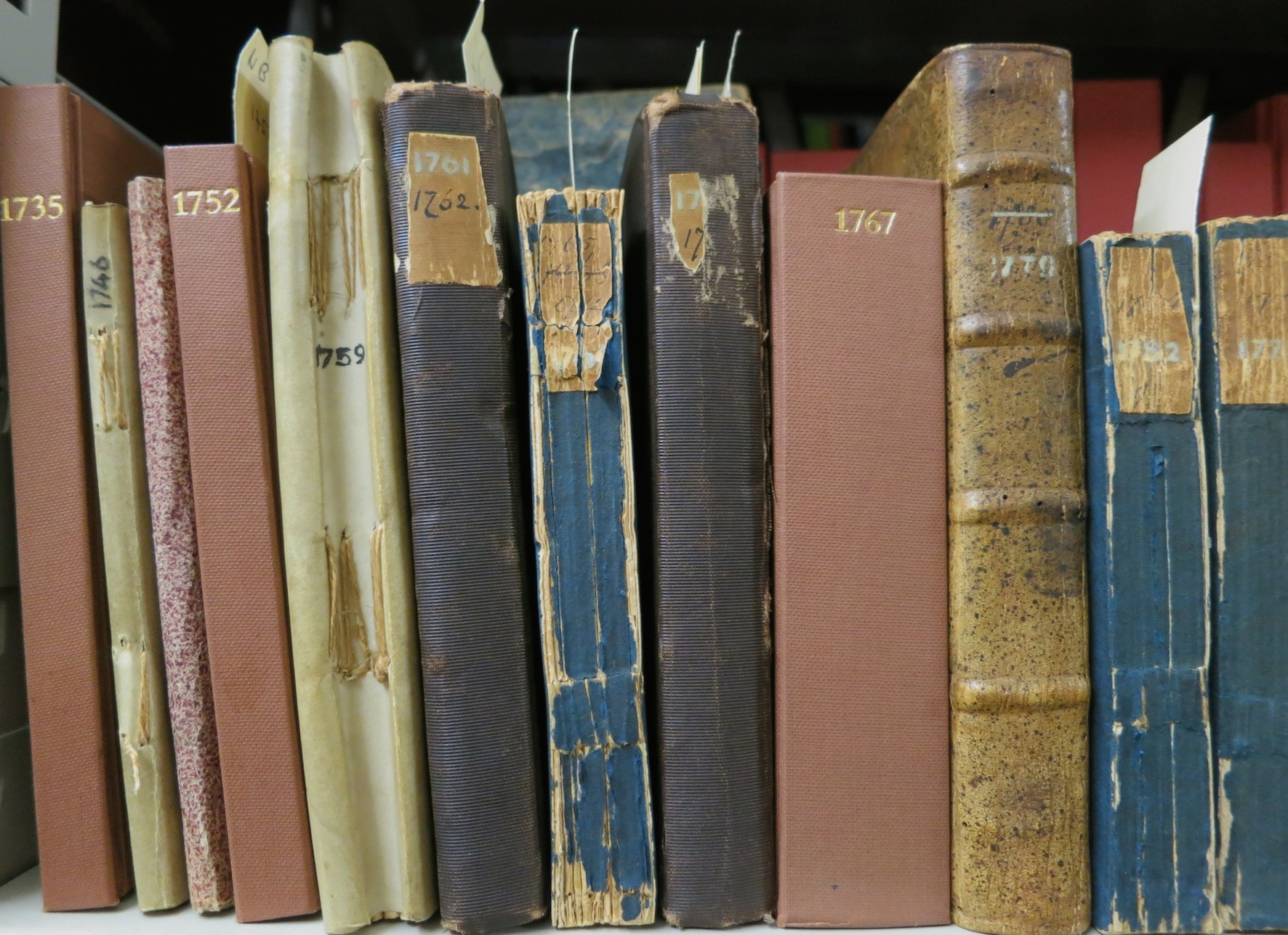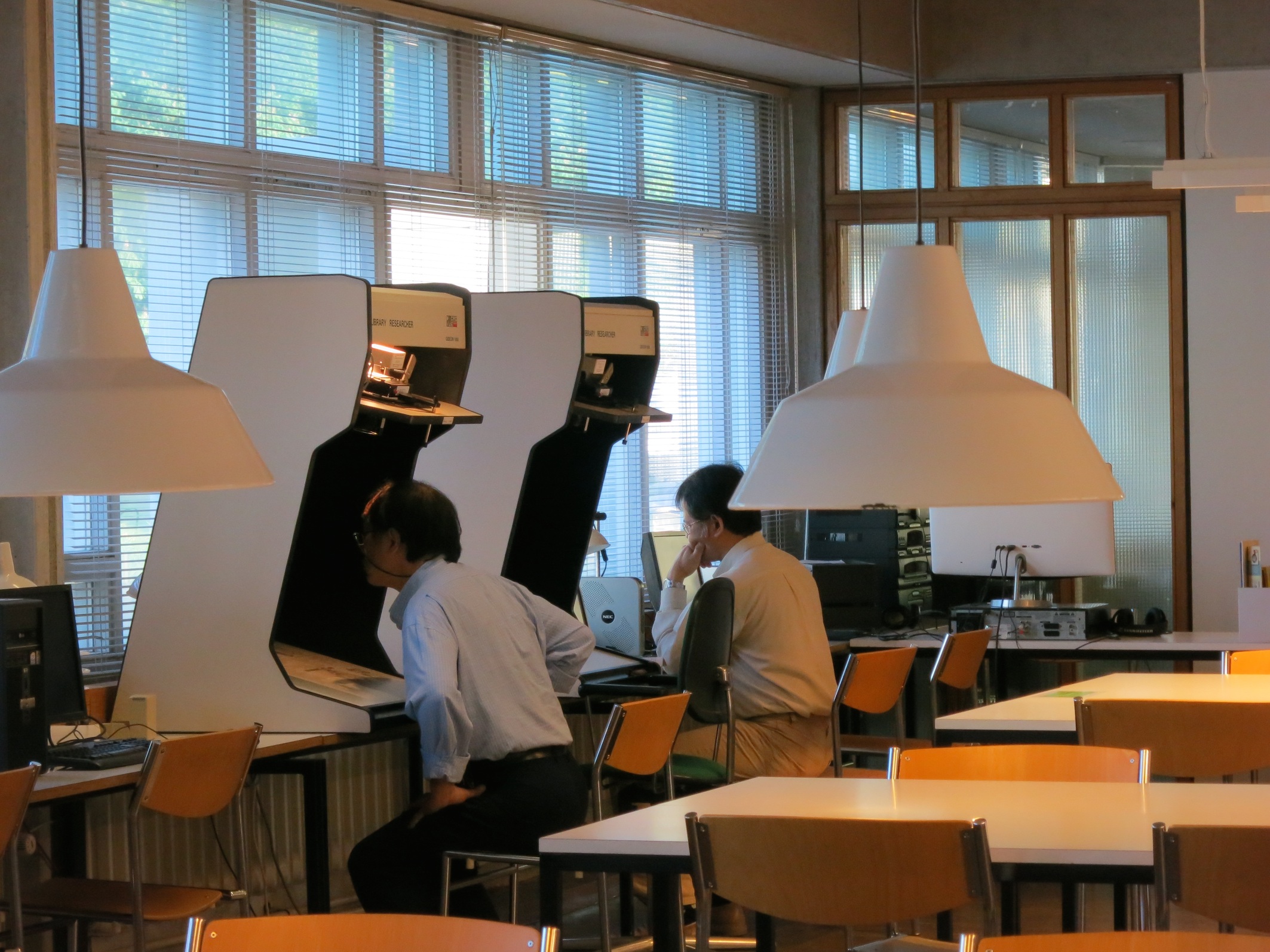Andy Fuller
The Reading Room enabled interactions between scholars - Andy FullerThe Royal Netherlands Institute of Southeast Asian and Caribbean Studies (KITLV) has suffered a major funding cut. The Institute, with its collection of some one million books and hundreds of thousands of other documents, images, maps and miscellanea, many of them concerning Indonesia, dates back to 1851, an era that also saw the founding of Leiden’s Volkenkunde Museum (1837) and the Tropenmuseum (1864) in Amsterdam. This was the era of high colonialism, when many artefacts from the colonies could be easily transported back to the centre of colonial authority. The KITLV collection is also home to many documents from Suriname, another colony of the Dutch.
To avoid possible dissolution, the KITLV recently made some compromises to reduce the cost of its services, such as the maintenance of its famous Reading Room. Over its last few months of operations, the Reading Room was decorated with notices in Dutch, English and Indonesian in bold type stating that its last day of operation would be June 27th.
Professor William Frederick from Ohio University, a long time user of the KITLV’s collection, wrote a letter bemoaning its closure. The letter reflects the sense of attachment felt by the room’s long time users: ‘I have returned as often as possible over the years, and taken the more or less inevitable changes in stride: the retirement of coffee trolleys and service, the move to the Reuvenplaats, the banishment of the dear cat who often kept my lap warm on winter days in the Reading Room.’ The nostalgia in the letter dissolves into something more forceful: ‘though some of [the initial proposals] were modified, I saw and continue to see, the remaining changes as a shameless and both intellectually and fiscally irresponsible savaging of a unique and priceless tradition, and of a peerless, world-class research facility.’
Reading Room Routines
I carried out research in the Reading Room during its last months, and have fond memories of its routines. As I approach the building in the morning grey, a man stands by the doorway wearing brown leather shoes, a faded pair of jeans and a thick grey jumper. He’s reading a print-out of a journal article. A moment later, a couple of staff from a neighbouring institute come in with a trolley and to remove a couple number of boxes of books and journals. Staff walk into the building barely looking up, a sense of purpose in their stride.
 More than a million books fill the Institute’s subterranean storeroom - Andy FullerA moment later, after checking the clock, Rini Hogewoning unlocks the door to the Reading Room and says, ‘welkom’ to the waiting visitors, in a voice that is both proud and friendly. Rini has worked at the Reading Room for some 30 years. Her colleague, Josephine, commenced more recently. They greet visitors with a direct ‘Morgen!’ (Good morning) and perform their duties with an informal ‘alsjeblieft!’ (if you please!) and a smile. The Reading Room offers both the professional formality of a ‘peerless’ research institute and the informality that develops amongst well-known, familiar colleagues. It is a specialised environment designed to enable access to the KITLV’s collection. It provides a space in which scholars can easily interact, and experience the occasional fortuitous meeting.
More than a million books fill the Institute’s subterranean storeroom - Andy FullerA moment later, after checking the clock, Rini Hogewoning unlocks the door to the Reading Room and says, ‘welkom’ to the waiting visitors, in a voice that is both proud and friendly. Rini has worked at the Reading Room for some 30 years. Her colleague, Josephine, commenced more recently. They greet visitors with a direct ‘Morgen!’ (Good morning) and perform their duties with an informal ‘alsjeblieft!’ (if you please!) and a smile. The Reading Room offers both the professional formality of a ‘peerless’ research institute and the informality that develops amongst well-known, familiar colleagues. It is a specialised environment designed to enable access to the KITLV’s collection. It provides a space in which scholars can easily interact, and experience the occasional fortuitous meeting.
Lights hang low over broad desks: these are used for the reading of manuscripts and old texts, all of which happens within the gaze of the librarians. A line of desks face out on to the Witte Singel – one of the main canals that define the city limits of Leiden. There are machines for the consultation of microfilm at which scholars scroll forever downwards or horizontally. The Malaysian Studies room is somewhat more private and the door is sometimes closed. This room looks out onto a neighbouring basketball court and the activities of school children can provide some light entertainment for scholars in between writing or reading some text. The leisure boats gently float by on the Singel, another example of Leiden’s quiet pleasures.
On one side of the room there are numerous computers for searching the catalogue. There are racks of newspapers from Indonesia and Suriname, behind which are the shelves of Asian studies and anthropological journals. Here one also finds popular magazines in Sundanese and Javanese which might be hard to find even in Indonesia. Yet, here they are clearly visible and easily accessible. Newspapers from the previous week or month endure, proving to be less ephemeral than the events they describe.
Downsizing
‘The KITLV moved here in 1975. There have been people who have been working here for a long time and each of them—each of us—are dealing with the situation in different ways,’ says Dr Reinder Storm. As head of collections at the KITLV, Reinder is disappointed at the prospect of the Reading Room’s closure. But he is also pragmatic. ‘Much will be lost, no doubt about it. Some staff are looking for new jobs. But it is not as bad as it could be. The ambience will be lost and so will the ability of researchers to engage with the librarians who are so knowledgeable of the collection.’ The KITLV is not the only grand institute in The Netherlands facing significant downsizing. The Tropenmuseum, Volkenkunde and Africa Museums are all now being managed by one central group of managers.
‘When the collection moves to be handled by the University Library, the degree to which the documents are indexed will change. It is this information that makes the documents in the KITLV collection so easily searchable for users. The management at the University, however, regard such thorough indexing as to be a waste of time and money.’ But Reinder also acknowledges that it is more than this. ‘When people use the reading room, they have a sense of community. Scholars in one place. That will be lost when visiting scholars will use the library or some other space at the university or KITLV.’
 The Reading Room gained the affection of innumerable scholars - Andy FullerReinder emphasises the importance of the work of the Reading Room’s two most prominent and loyal staff, Rini Hogewoning and Josephine Schrama: ‘But, most importantly, what is lost is that researchers won’t be able to access the information and knowledge that is provided by Rini and Josephine. They can not only help people find particular texts, but, they are also vital in introducing researchers to other researchers who have similar interests. When the collection will be available through the University Library, researchers will pick up the books from the lockers on the ground floor. There will be no human interaction. And, if there is, it won’t be with a librarian who has some 30-40 years of experience with a very particular collection.’
The Reading Room gained the affection of innumerable scholars - Andy FullerReinder emphasises the importance of the work of the Reading Room’s two most prominent and loyal staff, Rini Hogewoning and Josephine Schrama: ‘But, most importantly, what is lost is that researchers won’t be able to access the information and knowledge that is provided by Rini and Josephine. They can not only help people find particular texts, but, they are also vital in introducing researchers to other researchers who have similar interests. When the collection will be available through the University Library, researchers will pick up the books from the lockers on the ground floor. There will be no human interaction. And, if there is, it won’t be with a librarian who has some 30-40 years of experience with a very particular collection.’
Reinder stresses that the collection will remain. This is in contrast with some of the rumours and stories that have been spreading about the KITLV, which have often taken on a doomsday-like narrative. ‘It is not as bad as it could be’ is hardly an optimistic and positive statement. Yet it is Reinder’s persistent message. Some of the staff are being retained to continue to work at the University Library, others will be looking for work, while others will take the opportunity of an early retirement.
The Collection Underground
Alfred Schipper has been working at the KITLV Reading Room for 30 years. ‘I have never been to Indonesia. But, maybe someday, I will.’ Each morning Alfred could be seen walking from his office near the stairwell, to the elevator, unlocking it with a key, and then taking the very short, but slightly slow descent, to the floor below. His job is to bring the materials ordered by researchers through the library’s catalogue to the Reading Room. His day is filled with many journeys down to the store where the books, CDs, DVDs, newspapers, maps, magazines and other paraphernalia are kept.
 The Institute’s collection of books on Indonesia is unrivalled in number and variety - Andy Fuller‘Each day there are about 100 books that I take and return. Some days, there are more, some days there are less.’ Alfred works to his own rhythm and system. The noise of the printer in his office, churning out the slips which name the books to be collected for library-users, contrasts with his quiet manner. The temperature below is maintained at around 17-18 degrees and the humidity is at 55 per cent. The silence of the store is broken only by the rolling of the trolley’s wheels and the sound of the machine that tracks the changes in the temperature and humidity. The KITLV collection will remain in this store, but the books will now be transported to the Leiden University Library across the other side of the canal.
The Institute’s collection of books on Indonesia is unrivalled in number and variety - Andy Fuller‘Each day there are about 100 books that I take and return. Some days, there are more, some days there are less.’ Alfred works to his own rhythm and system. The noise of the printer in his office, churning out the slips which name the books to be collected for library-users, contrasts with his quiet manner. The temperature below is maintained at around 17-18 degrees and the humidity is at 55 per cent. The silence of the store is broken only by the rolling of the trolley’s wheels and the sound of the machine that tracks the changes in the temperature and humidity. The KITLV collection will remain in this store, but the books will now be transported to the Leiden University Library across the other side of the canal.
The KITLV has been downsized and there is some resentment and disappointment. Professor Frederick’s letter is only one of a number of signs of this. He expresses something intangible: with the closure of the Reading Room, the sense of privilege one could enjoy in having such direct and familiar access to the KITLV’s unrivalled collection is gone. Ten thousand visitors come to KITLV’s Reading Room per year and now their interaction with the Institute has been shifted to the Leiden University library. The muted response of staff and users belies a sense of deep regret at the changes being applied to KITLV.
Andy Fuller (fuller.andy@gmail.com) is an Associate Fellow at KITLV, Leiden, The Netherlands. His website is readingsideways.net.
Inside Indonesia 118: Oct-Dec 2014
{jcomments on}
